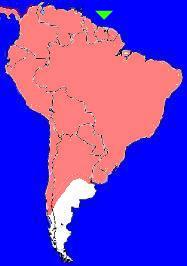 Osprey (Pandion haliaetus)
Osprey (Pandion haliaetus)
 Osprey (Pandion haliaetus)
Osprey (Pandion haliaetus) |
 |
| The ospreys come to Suriname from North America. Most of them are here from August to April, but some spend the whole northern summer in Suriname, as can be seen in the graph below. Most of them fish in the lagoons in the northern part of Suriname and once as many as 30 were seen above and around the same lagoon (Bigipan, Ribot, februari 1981). But you can also find them fishing in rivers far from the coast. Flying over the water, they dive down with their feet first to grab a fish, then fly off to a tree to eat it. The first picture is made by Pieter Verheij above the Suriname river in February 2005. Then follows a series of 4 pictures of an attacking osprey (photographed by R.Ribot). These pictures are made of the same osprey flying above New Nickerie in Suriname. It glides above a waterway (1) looking for fish, then it hoovers above a spotted fish (2), it dives (3) and adjust its course just above the water (4). Ospreys are present in all months, but, as can be espected, less of them are seen in the northern summer, when to go to breed in North-America. Probably a lot of young birds stay behind. The sixth photo is made of an osprey in June 2007 at Weg naar Zee, seen by Erik Toorman. This bird will not breed in that year, too late to fly back I think. The last picture was made by Paul Baker at Warappakreek in February 2013. Dominiek Plouvier made two videos, one of calling Osprey and one of a eating Osprey. |
 |
| Video (click the link or the 'play'-button to see) | ||
|---|---|---|
| Video recording of a Osprey © ; | Video recording of a Osprey © ; |
|
|
||||||||||||||||||||||||||||||||||||||||||||
| Observations through the year | Observations of breeding through the year |
|---|---|
| The 849 reported observations of this bird in Suriname, mainly for the last 50 years up to 2018, have been grouped by month. More birds on one day are counted as one observation. Of course, if the graph should depict the total number of birds seen, the differences between the months could be much more pronounced. | The reported breeding observations of this bird in Suriname. Most observations are about nest with eggs, some about fledglings, or feeding at a nest or the building of a nest. Of the about 5000 nests and eggs found for all species together, about 1/3 comes from the egg collection of Penard between 1896 and 1905. For some reason most collecting then was done in the first half of each year, so the shown distribution does not necessarily reflect the actual breeding preferences. The main dry season in Suriname is reckoned to be from half August to the end of November, the main wet season from half April to half August, but the the timing of begin and end does vary from year to year. Around March a second dry season often occurs. |